Moses
Moses (/ˈmoʊzɪz, -zɪs/),[2][Note 1] also known as Moshe Rabbenu (Hebrew: מֹשֶׁה רַבֵּנוּ, lit. 'Moses our Teacher'), is the most important prophet in Judaism,[3][4] and an important prophet in Christianity, Islam, the Bahá'í Faith, and a number of other Abrahamic religions. In the biblical narrative he was the leader of the Israelites and lawgiver, to whom the authorship of the first five books of the bible, the Torah, or "acquisition of the Torah from heaven," is attributed.
Moses | |
|---|---|
 Moses with the Ten Commandments by Philippe de Champaigne, 1648 | |
| Born | |
| Died | Mount Nebo, Moab |
| Nationality | Israelite |
| Known for | Prophet |
| Spouse(s) | |
| Children | |
| Parent(s) |
|
| Relatives | |
Rabbinical Judaism calculated a lifespan of Moses corresponding to 1391–1271 BCE;[5] Jerome suggested 1592 BCE,[6] and James Ussher suggested 1571 BCE as his birth year.[7][Note 2] Scholarly consensus sees Moses as a legendary figure, while retaining the possibility that a Moses-like figure existed.[10][11][12][13]
According to the Book of Exodus, Moses was born in a time when his people, the Israelites, an enslaved minority, were increasing in population and, as a result, the Egyptian Pharaoh worried that they might ally themselves with Egypt's enemies.[14] Moses' Hebrew mother, Jochebed, secretly hid him when the Pharaoh ordered all newborn Hebrew boys to be killed in order to reduce the population of the Israelites. Through the Pharaoh's daughter (identified as Queen Bithia in the Midrash), the child was adopted as a foundling from the Nile river and grew up with the Egyptian royal family. After killing an Egyptian slave-master who was beating a Hebrew, Moses fled across the Red Sea to Midian, where he encountered the Angel of the Lord,[15] speaking to him from within a burning bush on Mount Horeb, which he regarded as the Mountain of God.
God sent Moses back to Egypt to demand the release of the Israelites from slavery. Moses said that he could not speak eloquently,[16] so God allowed Aaron, his elder brother,[17] to become his spokesperson. After the Ten Plagues, Moses led the Exodus of the Israelites out of Egypt and across the Red Sea, after which they based themselves at Mount Sinai, where Moses received the Ten Commandments. After 40 years of wandering in the desert, Moses died within sight of the Promised Land on Mount Nebo.
Etymology of name
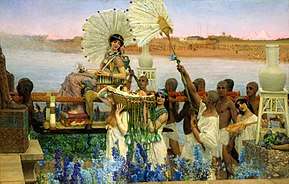
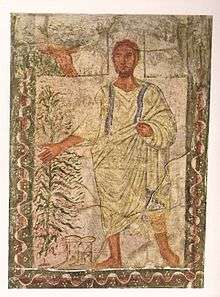
Several etymologies for the name "Moses" have been proposed.
An Egyptian root msy ('child of') has been considered as a possible etymology, arguably an abbreviation of a theophoric name, as for example in Egyptian names like Thutmoses ('child of Thoth') and Ramesses ('child of Ra'),[18] with the god's name omitted. Abraham Yahuda, based on the spelling given in the Tanakh, argues that it combines "water" or "seed" and "pond, expanse of water," thus yielding the sense of "child of the Nile" (mw-še).[19]
The Biblical account of Moses' birth provides him with a folk etymology to explain the ostensible meaning of his name.[18][20] He is said to have received it from the Pharaoh's daughter: "he became her son. She named him Moses (Moshe), saying, 'I drew him out (meshitihu) of the water'."[21][22] This explanation links it to a verb mashah, meaning 'to draw out', which makes the Pharaoh's daughter's declaration a play on words.[22][23] The princess made a grammatical mistake which is prophetic of his future role in legend, as someone who will "draw the people of Israel out of Egypt through the waters of the Red Sea."[24]
The Hebrew etymology in the Biblical story may reflect an attempt to cancel out traces of Moses' Egyptian origins.[24] The Egyptian character of his name was recognized as such by ancient Jewish writers like Philo and Josephus.[24] Philo linked Moses's name (Ancient Greek: Μωϋσῆς, romanized: Mōysēs, lit. 'Mōusḗs') to the Egyptian (Coptic) word for 'water' (möu, μῶυ), in reference to his finding in the Nile and the biblical folk etymology.[25] Josephus, in his Antiquities of the Jews, claims that the second element, -esês, meant 'those who are saved'. The problem of how an Egyptian princess, known to Josephus as Thermutis (identified as Tharmuth)[22] and in later Jewish tradition as Bithiah,[26] could have known Hebrew puzzled medieval Jewish commentators like Abraham ibn Ezra and Hezekiah ben Manoah. Hezekiah suggested she either converted or took a tip from Jochebed.[27][28]
Biblical narrative
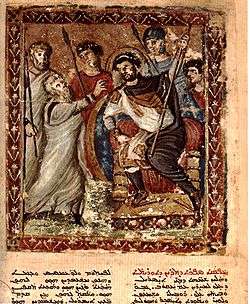
Prophet and deliverer of Israel
The Israelites had settled in the Land of Goshen in the time of Joseph and Jacob, but a new Pharaoh arose who oppressed the children of Israel. At this time Moses was born to his father Amram, son (or descendant) of Kehath the Levite, who entered Egypt with Jacob's household; his mother was Jochebed (also Yocheved), who was kin to Kehath. Moses had one older (by seven years) sister, Miriam, and one older (by three years) brother, Aaron.[Note 3] The Pharaoh had commanded that all male Hebrew children born would be drowned in the river Nile, but Moses' mother placed him in an ark and concealed the ark in the bulrushes by the riverbank, where the baby was discovered and adopted by Pharaoh's daughter, and raised as an Egyptian. One day, after Moses had reached adulthood, he killed an Egyptian who was beating a Hebrew. Moses, in order to escape the Pharaoh's death penalty, fled to Midian (a desert country south of Judah), where he married Zipporah.[30]
There, on Mount Horeb, God appeared to Moses as a burning bush, revealed to Moses his name YHWH (probably pronounced Yahweh)[31] and commanded him to return to Egypt and bring his chosen people (Israel) out of bondage and into the Promised Land (Canaan).[32] During the journey, God tried to kill Moses, but Zipporah saved his life. Moses returned to carry out God's command, but God caused the Pharaoh to refuse, and only after God had subjected Egypt to ten plagues did the Pharaoh relent. Moses led the Israelites to the border of Egypt, but there God hardened the Pharaoh's heart once more, so that he could destroy the Pharaoh and his army at the Red Sea Crossing as a sign of his power to Israel and the nations.[33]
After defeating the Amalekites in Rephidim, Moses led the Israelites to biblical Mount Sinai, where he was given the Ten Commandments from God, written on stone tablets. However, since Moses remained a long time on the mountain, some of the people feared that he might be dead, so they made a statue of a golden calf and worshipped it, thus disobeying and angering God and Moses. Moses, out of anger, broke the tablets, and later ordered the elimination of those who had worshiped the golden statue, which was melted down and fed to the idolaters.[34] He also wrote the ten commandments on a new set of tablets. Later at Mount Sinai, Moses and the elders entered into a covenant, by which Israel would become the people of YHWH, obeying his laws, and YHWH would be their god. Moses delivered the laws of God to Israel, instituted the priesthood under the sons of Moses' brother Aaron, and destroyed those Israelites who fell away from his worship. In his final act at Sinai, God gave Moses instructions for the Tabernacle, the mobile shrine by which he would travel with Israel to the Promised Land.[35]
From Sinai, Moses led the Israelites to the Desert of Paran on the border of Canaan. From there he sent twelve spies into the land. The spies returned with samples of the land's fertility, but warned that its inhabitants were giants. The people were afraid and wanted to return to Egypt, and some rebelled against Moses and against God. Moses told the Israelites that they were not worthy to inherit the land, and would wander the wilderness for forty years until the generation who had refused to enter Canaan had died, so that it would be their children who would possess the land.[36]
When the forty years had passed, Moses led the Israelites east around the Dead Sea to the territories of Edom and Moab. There they escaped the temptation of idolatry, conquered the lands of Og and Sihon in Transjordan, received God's blessing through Balaam the prophet, and massacred the Midianites, who by the end of the Exodus journey had become the enemies of the Israelites due to their notorious role in enticing the Israelites to sin against God. Moses was twice given notice that he would die before entry to the Promised Land: in Numbers 27:13, once he had seen the Promised Land from a viewpoint on Mount Abarim, and again in Numbers 31:1 once battle with the Midianites had been won.
On the banks of the Jordan River, in sight of the land, Moses assembled the tribes. After recalling their wanderings he delivered God's laws by which they must live in the land, sang a song of praise and pronounced a blessing on the people, and passed his authority to Joshua, under whom they would possess the land. Moses then went up Mount Nebo to the top of Pisgah, looked over the promised land of Israel spread out before him, and died, at the age of one hundred and twenty. More humble than any other man (Num. 12:3), "there hath not arisen a prophet since in Israel like unto Moses, whom YHWH knew face to face" (Deuteronomy 34:10). The New Testament states that after Moses' death, Michael the Archangel and the Devil disputed over his body (Epistle of Jude 1:9).
Lawgiver of Israel
Moses is honoured among Jews today as the "lawgiver of Israel", and he delivers several sets of laws in the course of the four books. The first is the Covenant Code (Exodus 20:19–23:33), the terms of the covenant which God offers to the Israelites at biblical Mount Sinai. Embedded in the covenant are the Decalogue (the Ten Commandments, Exodus 20:1–17) and the Book of the Covenant (Exodus 20:22–23:19).[37] The entire Book of Leviticus constitutes a second body of law, the Book of Numbers begins with yet another set, and the Book of Deuteronomy another.
Moses has traditionally been regarded as the author of those four books and the Book of Genesis, which together comprise the Torah, the first section of the Hebrew Bible.[38]
Historicity
The modern scholarly consensus is that the figure of Moses is a mythical figure,[10] and while, as William G. Dever writes, "a Moses-like figure may have existed somewhere in the southern Transjordan in the mid-late 13th century B.C.", archaeology cannot confirm his existence.[12] Certainly no Egyptian sources mention Moses or the events of Exodus–Deuteronomy, nor has any archaeological evidence been discovered in Egypt or the Sinai wilderness to support the story in which he is the central figure.[39] The story of his discovery picks up a familiar motif in ancient Near Eastern mythological accounts of the ruler who rises from humble origins. Thus Sargon of Akkad's Akkadian account of his own origins runs:
My mother, the high priestess, conceived; in secret she bore me
She set me in a basket of rushes, with bitumen she sealed my lid
She cast me into the river which rose over me.[40]
Despite the imposing fame associated with Moses, no source mentions him until he emerges in texts associated with the Babylonian exile.[41] A theory developed by Cornelis Tiele in 1872, which has proved influential, argued that Yahweh was a Midianite god, introduced to the Israelites by Moses, whose father-in-law Jethro was a Midianite priest.[42] It was to such a Moses that Yahweh reveals his real name, hidden from the Patriarchs who knew him only as El Shaddai.[43] Against this view is the modern consensus that most of the Israelites were native to Palestine.[44] Martin Noth argued that the Pentateuch uses the figure of Moses, originally linked to legends of a Transjordan conquest, as a narrative bracket or late redactional device to weld together 4 of the 5, originally independent, themes of that work.[41][45] Manfred Görg[46] and Rolf Krauss,[47] the latter in a somewhat sensationalist manner,[48] have suggested that the Moses story is a distortion or transmogrification of the historical pharaoh Amenmose (c. 1200 BCE), who was dismissed from office and whose name was later simplified to msy (Mose). Aidan Dodson regards this hypothesis as "intriguing, but beyond proof."[49] Rudolf Smend argues that the two details about Moses that were most likely to be historical are his name, of Egyptian origin, and his marriage to a Midianite woman, details which seem unlikely to have been invented by the Israelites; in Smend's view, all other details given in the biblical narrative are too mythically charged to be seen as accurate data.[50]
The name King Mesha of Moab has been linked to that of Moses. Mesha also is associated with narratives of an exodus and a conquest, and several motifs in stories about him are shared with the Exodus tale and that regarding Israel's war with Moab (2 Kings 3). Moab rebels against oppression, like Moses, leads his people out of Israel, as Moses does from Egypt, and his first-born son is slaughtered at the wall of Kir-hareseth as the firstborn of Israel are condemned to slaughter in the Exodus story, "an infernal passover that delivers Mesha while wrath burns against his enemies".[51]
An Egyptian version of the tale that crosses over with the Moses story is found in Manetho who, according to the summary in Josephus, wrote that a certain Osarseph, a Heliopolitan priest, became overseer of a band of lepers, when Amenophis, following indications by Amenhotep, son of Hapu, had all the lepers in Egypt quarantined in order to cleanse the land so that he might see the gods. The lepers are bundled into Avaris, the former capital of the Hyksos, where Osarseph prescribes for them everything forbidden in Egypt, while proscribing everything permitted in Egypt. They invite the Hyksos to reinvade Egypt, rule with them for 13 years – Osarseph then assumes the name Moses – and are then driven out.[52]
Other Egyptian figures which have been postulated as candidates for a historical Moses-like figure include the princes Ahmose-ankh and Ramose, who were sons of pharaoh Ahmose I, or a figure associated with the family of pharaoh Thutmose III.[53][54]
Hellenistic literature
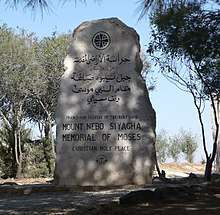
Non-biblical writings about Jews, with references to the role of Moses, first appear at the beginning of the Hellenistic period, from 323 BCE to about 146 BCE. Shmuel notes that "a characteristic of this literature is the high honour in which it holds the peoples of the East in general and some specific groups among these peoples."[55]
In addition to the Judeo-Roman or Judeo-Hellenic historians Artapanus, Eupolemus, Josephus, and Philo, a few non-Jewish historians including Hecataeus of Abdera (quoted by Diodorus Siculus), Alexander Polyhistor, Manetho, Apion, Chaeremon of Alexandria, Tacitus and Porphyry also make reference to him. The extent to which any of these accounts rely on earlier sources is unknown.[56] Moses also appears in other religious texts such as the Mishnah (c. 200 CE), Midrash (200–1200 CE),[57] and the Quran (c. 610–653).
The figure of Osarseph in Hellenistic historiography is a renegade Egyptian priest who leads an army of lepers against the pharaoh and is finally expelled from Egypt, changing his name to Moses.
Hecataeus
The earliest existing reference to Moses in Greek literature occurs in the Egyptian history of Hecataeus of Abdera (4th century BCE). All that remains of his description of Moses are two references made by Diodorus Siculus, wherein, writes historian Arthur Droge, he "describes Moses as a wise and courageous leader who left Egypt and colonized Judaea."[58] Among the many accomplishments described by Hecataeus, Moses had founded cities, established a temple and religious cult, and issued laws:
After the establishment of settled life in Egypt in early times, which took place, according to the mythical account, in the period of the gods and heroes, the first... to persuade the multitudes to use written laws was Mneves [Moses], a man not only great of soul but also in his life the most public-spirited of all lawgivers whose names are recorded.[58]
Droge also points out that this statement by Hecataeus was similar to statements made subsequently by Eupolemus.[58]
Artapanus
The Jewish historian Artapanus of Alexandria (2nd century BCE), portrayed Moses as a cultural hero, alien to the Pharaonic court. According to theologian John Barclay, the Moses of Artapanus "clearly bears the destiny of the Jews, and in his personal, cultural and military splendor, brings credit to the whole Jewish people."[59]
Jealousy of Moses' excellent qualities induced Chenephres to send him with unskilled troops on a military expedition to Ethiopia, where he won great victories. After having built the city of Hermopolis, he taught the people the value of the ibis as a protection against the serpents, making the bird the sacred guardian spirit of the city; then he introduced circumcision. After his return to Memphis, Moses taught the people the value of oxen for agriculture, and the consecration of the same by Moses gave rise to the cult of Apis. Finally, after having escaped another plot by killing the assailant sent by the king, Moses fled to Arabia, where he married the daughter of Raguel [Jethro], the ruler of the district.[60]
Artapanus goes on to relate how Moses returns to Egypt with Aaron, and is imprisoned, but miraculously escapes through the name of YHWH in order to lead the Exodus. This account further testifies that all Egyptian temples of Isis thereafter contained a rod, in remembrance of that used for Moses' miracles. He describes Moses as 80 years old, "tall and ruddy, with long white hair, and dignified."
Some historians, however, point out the "apologetic nature of much of Artapanus' work,"[61] with his addition of extra-biblical details, such as his references to Jethro: the non-Jewish Jethro expresses admiration for Moses' gallantry in helping his daughters, and chooses to adopt Moses as his son.[62]
Strabo
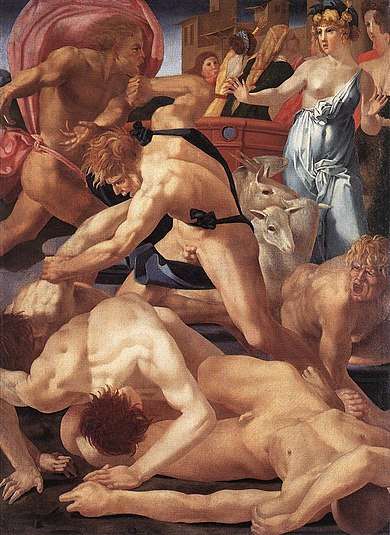
Strabo, a Greek historian, geographer and philosopher, in his Geographica (c. 24 CE), wrote in detail about Moses, whom he considered to be an Egyptian who deplored the situation in his homeland, and thereby attracted many followers who respected the deity. He writes, for example, that Moses opposed the picturing of the deity in the form of man or animal, and was convinced that the deity was an entity which encompassed everything – land and sea:[63]
35. An Egyptian priest named Moses, who possessed a portion of the country called the Lower Egypt, being dissatisfied with the established institutions there, left it and came to Judaea with a large body of people who worshipped the Divinity. He declared and taught that the Egyptians and Africans entertained erroneous sentiments, in representing the Divinity under the likeness of wild beasts and cattle of the field; that the Greeks also were in error in making images of their gods after the human form. For God [said he] may be this one thing which encompasses us all, land and sea, which we call heaven, or the universe, or the nature of things....
36. By such doctrine Moses persuaded a large body of right-minded persons to accompany him to the place where Jerusalem now stands....[64]
In Strabo's writings of the history of Judaism as he understood it, he describes various stages in its development: from the first stage, including Moses and his direct heirs; to the final stage where "the Temple of Jerusalem continued to be surrounded by an aura of sanctity." Strabo's "positive and unequivocal appreciation of Moses' personality is among the most sympathetic in all ancient literature."[65] His portrayal of Moses is said to be similar to the writing of Hecataeus who "described Moses as a man who excelled in wisdom and courage."[65]
Egyptologist Jan Assmann concludes that Strabo was the historian "who came closest to a construction of Moses' religion as monotheistic and as a pronounced counter-religion." It recognized "only one divine being whom no image can represent... [and] the only way to approach this god is to live in virtue and in justice."[66]
Tacitus
The Roman historian Tacitus (c. 56–120 CE) refers to Moses by noting that the Jewish religion was monotheistic and without a clear image. His primary work, wherein he describes Jewish philosophy, is his Histories (c. 100), where, according to 18th-century translator and Irish dramatist Arthur Murphy, as a result of the Jewish worship of one God, "pagan mythology fell into contempt."[67] Tacitus states that, despite various opinions current in his day regarding the Jews' ethnicity, most of his sources are in agreement that there was an Exodus from Egypt. By his account, the Pharaoh Bocchoris, suffering from a plague, banished the Jews in response to an oracle of the god Zeus-Amun.
A motley crowd was thus collected and abandoned in the desert. While all the other outcasts lay idly lamenting, one of them, named Moses, advised them not to look for help to gods or men, since both had deserted them, but to trust rather in themselves, and accept as divine the guidance of the first being, by whose aid they should get out of their present plight.[68]
In this version, Moses and the Jews wander through the desert for only six days, capturing the Holy Land on the seventh.[68]
Longinus
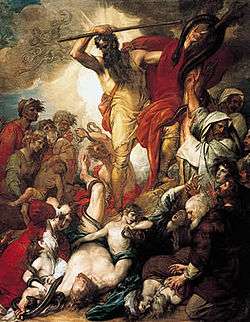
The Septuagint, the Greek version of the Hebrew Bible, influenced Longinus, who may have been the author of the great book of literary criticism, On the Sublime. The date of composition is unknown, but it is commonly assigned to the late 1st century C.E.[69]
The writer quotes Genesis in a "style which presents the nature of the deity in a manner suitable to his pure and great being," however he does not mention Moses by name, calling him 'no chance person' (οὐχ ὁ τυχὼν ἀνήρ) but "the Lawgiver" (θεσμοθέτης, thesmothete) of the Jews," a term that puts him on a par with Lycurgus and Minos.[70] Aside from a reference to Cicero, Moses is the only non-Greek writer quoted in the work, contextually he is put on a par with Homer,[71] and he is described "with far more admiration than even Greek writers who treated Moses with respect, such as Hecataeus and Strabo.[72]
Josephus
In Josephus' (37 – c. 100 CE) Antiquities of the Jews, Moses is mentioned throughout. For example Book VIII Ch. IV, describes Solomon's Temple, also known as the First Temple, at the time the Ark of the Covenant was first moved into the newly built temple:
When King Solomon had finished these works, these large and beautiful buildings, and had laid up his donations in the temple, and all this in the interval of seven years, and had given a demonstration of his riches and alacrity therein; ...he also wrote to the rulers and elders of the Hebrews, and ordered all the people to gather themselves together to Jerusalem, both to see the temple which he had built, and to remove the ark of God into it; and when this invitation of the whole body of the people to come to Jerusalem was everywhere carried abroad, ...The Feast of Tabernacles happened to fall at the same time, which was kept by the Hebrews as a most holy and most eminent feast. So they carried the ark and the tabernacle which Moses had pitched, and all the vessels that were for ministration to the sacrifices of God, and removed them to the temple. ...Now the ark contained nothing else but those two tables of stone that preserved the ten commandments, which God spake to Moses in Mount Sinai, and which were engraved upon them...[73]
According to Feldman, Josephus also attaches particular significance to Moses' possession of the "cardinal virtues of wisdom, courage, temperance, and justice." He also includes piety as an added fifth virtue. In addition, he "stresses Moses' willingness to undergo toil and his careful avoidance of bribery. Like Plato's philosopher-king, Moses excels as an educator."[74]
Numenius
Numenius, a Greek philosopher who was a native of Apamea, in Syria, wrote during the latter half of the 2nd century CE. Historian Kennieth Guthrie writes that "Numenius is perhaps the only recognized Greek philosopher who explicitly studied Moses, the prophets, and the life of Jesus..."[75] He describes his background:
Numenius was a man of the world; he was not limited to Greek and Egyptian mysteries, but talked familiarly of the myths of Brahmins and Magi. It is however his knowledge and use of the Hebrew scriptures which distinguished him from other Greek philosophers. He refers to Moses simply as "the prophet", exactly as for him Homer is the poet. Plato is described as a Greek Moses.[76]
Justin Martyr
The Christian saint and religious philosopher Justin Martyr (103–165 CE) drew the same conclusion as Numenius, according to other experts. Theologian Paul Blackham notes that Justin considered Moses to be "more trustworthy, profound and truthful because he is older than the Greek philosophers."[77] He quotes him:
I will begin, then, with our first prophet and lawgiver, Moses... that you may know that, of all your teachers, whether sages, poets, historians, philosophers, or lawgivers, by far the oldest, as the Greek histories show us, was Moses, who was our first religious teacher.[77]
Abrahamic religions
Prophet Moses | |
|---|---|
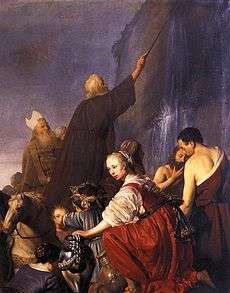 Moses striking the rock, 1630 by Pieter de Grebber | |
| Prophet, Saint, Seer, Lawgiver, Apostle to Pharaoh, Reformer | |
| Born | Goshen, Lower Egypt |
| Died | Mount Nebo, Moab |
| Venerated in | Judaism, Christianity, Islam, Bahá'í Faith |
| Feast | Orthodox Church & Catholic Church: Sept 4 |
| Attributes | Tablets of the Law |
Judaism
Most of what is known about Moses from the Bible comes from the books of Exodus, Leviticus, Numbers and Deuteronomy.[78] The majority of scholars consider the compilation of these books to go back to the Persian period, 538–332 BCE, but based on earlier written and oral traditions.[79][80] There is a wealth of stories and additional information about Moses in the Jewish apocrypha and in the genre of rabbinical exegesis known as Midrash, as well as in the primary works of the Jewish oral law, the Mishnah and the Talmud. Moses is also given a number of bynames in Jewish tradition. The Midrash identifies Moses as one of seven biblical personalities who were called by various names.[81] Moses' other names were Jekuthiel (by his mother), Heber (by his father), Jered (by Miriam), Avi Zanoah (by Aaron), Avi Gedor (by Kohath), Avi Soco (by his wet-nurse), Shemaiah ben Nethanel (by people of Israel).[82] Moses is also attributed the names Toviah (as a first name), and Levi (as a family name) (Vayikra Rabbah 1:3), Heman,[83] Mechoqeiq (lawgiver)[84] and Ehl Gav Ish (Numbers 12:3).[85] In another exegesis, Moses had ascended to the first heaven until the seventh, even visited Paradise and Hell alive, after he saw the Divine vision in Mount Horeb.[86]
Jewish historians who lived at Alexandria, such as Eupolemus, attributed to Moses the feat of having taught the Phoenicians their alphabet,[87] similar to legends of Thoth. Artapanus of Alexandria explicitly identified Moses not only with Thoth/Hermes, but also with the Greek figure Musaeus (whom he called "the teacher of Orpheus"), and ascribed to him the division of Egypt into 36 districts, each with its own liturgy. He named the princess who adopted Moses as Merris, wife of Pharaoh Chenephres.[88]
Jewish tradition considers Moses to be the greatest prophet who ever lived.[89][90] Despite his importance, Judaism stresses that Moses was a human being, and is therefore not to be worshipped.[91] Only God is worthy of worship in Judaism.
To Orthodox Jews, Moses is called Moshe Rabbenu, `Eved HaShem, Avi haNeviim zya"a: "Our Leader Moshe, Servant of God, Father of all the Prophets (may his merit shield us, amen)".[92] In the orthodox view, Moses received not only the Torah, but also the revealed (written and oral) and the hidden (the `hokhmat nistar teachings, which gave Judaism the Zohar of the Rashbi, the Torah of the Ari haQadosh and all that is discussed in the Heavenly Yeshiva between the Ramhal and his masters).
Arising in part from his age of death (120 according to Deut. 34:7) and that "his eye had not dimmed, and his vigor had not diminished," the phrase "may you live to 120" has become a common blessing among Jews, especially since 120 is elsewhere stated as the maximum age for Noah's descendants (one interpretation of Genesis 6:3).
Christianity
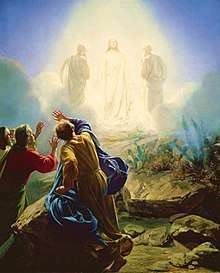
Moses is mentioned more often in the New Testament than any other Old Testament figure. For Christians, Moses is often a symbol of God's law, as reinforced and expounded on in the teachings of Jesus. New Testament writers often compared Jesus' words and deeds with Moses' to explain Jesus' mission. In Acts 7:39–43, 51–53, for example, the rejection of Moses by the Jews who worshipped the golden calf is likened to the rejection of Jesus by the Jews that continued in traditional Judaism.[93][94]
Moses also figures in several of Jesus' messages. When he met the Pharisee Nicodemus at night in the third chapter of the Gospel of John, he compared Moses' lifting up of the bronze serpent in the wilderness, which any Israelite could look at and be healed, to his own lifting up (by his death and resurrection) for the people to look at and be healed. In the sixth chapter, Jesus responded to the people's claim that Moses provided them manna in the wilderness by saying that it was not Moses, but God, who provided. Calling himself the "bread of life", Jesus stated that He was provided to feed God's people.[95]
Moses, along with Elijah, is presented as meeting with Jesus in all three Synoptic Gospels of the Transfiguration of Jesus in Matthew 17, Mark 9, and Luke 9, respectively. In Matthew 23, in what is the first attested use of a phrase referring to this rabbinical usage (the Graeco-Aramaic קתדרא דמשה), Jesus refers to the scribes and the Pharisees, in a passage critical of them, as having seated themselves "on the chair of Moses" (Greek: Ἐπὶ τῆς Μωϋσέως καθέδρας, epì tēs Mōüséōs kathédras) [96][97]
His relevance to modern Christianity has not diminished. Moses is considered to be a saint by several churches; and is commemorated as a prophet in the respective Calendars of Saints of the Eastern Orthodox Church, the Roman Catholic Church, and the Lutheran churches on September 4. In Eastern Orthodox liturgics for September 4, Moses is commemorated as the "Holy Prophet and God-seer Moses, on Mount Nebo".[98][99][Note 4] The Orthodox Church also commemorates him on the Sunday of the Forefathers, two Sundays before the Nativity.[101]
The Armenian Apostolic Church commemorates him as one of the Holy Forefathers in their Calendar of Saints on July 30.[102]
Mormonism
Members of The Church of Jesus Christ of Latter-day Saints (colloquially called Mormons) generally view Moses in the same way that other Christians do. However, in addition to accepting the biblical account of Moses, Mormons include Selections from the Book of Moses as part of their scriptural canon.[103] This book is believed to be the translated writings of Moses, and is included in the Pearl of Great Price.[104]
Latter-day Saints are also unique in believing that Moses was taken to heaven without having tasted death (translated). In addition, Joseph Smith and Oliver Cowdery stated that on April 3, 1836, Moses appeared to them in the Kirtland Temple (located in Kirtland, Ohio) in a glorified, immortal, physical form and bestowed upon them the "keys of the gathering of Israel from the four parts of the earth, and the leading of the ten tribes from the land of the north."[105]
Islam
Prophet
|
|---|
1.png) The name Musa written in Islamic calligraphy followed by Peace be upon him |
|
|
Moses is mentioned more in the Quran than any other individual and his life is narrated and recounted more than that of any other Islamic prophet.[106] In general, Moses is described in ways which parallel the Islamic prophet Muhammad.[107] Like Muhammad, Moses is defined in the Quran as both prophet (nabi) and messenger (rasul), the latter term indicating that he was one of those prophets who brought a scripture and law to his people.[108][109]
One of the hadith, or traditional narratives about Muhammad's life, describes a meeting in heaven between Moses and Muhammad, which resulted in Muslims observing 5 daily prayers.[110] Huston Smith says this was "one of the crucial events in Muhammad's life".[111]
Moses is mentioned 502 times in the Quran; passages mentioning Moses include 2.49–61, 7.103–60, 10.75–93, 17.101–04, 20.9–97, 26.10–66, 27.7–14, 28.3–46, 40.23–30, 43.46–55, 44.17–31, and 79.15–25. and many others. Most of the key events in Moses' life which are narrated in the Bible are to be found dispersed through the different Surahs of the Quran, with a story about meeting Khidr which is not found in the Bible.[106]
In the Moses story related by the Quran, Jochebed is commanded by God to place Moses in an ark and cast him on the waters of the Nile, thus abandoning him completely to God's protection.[106][112] The Pharaoh's wife Asiya, not his daughter, found Moses floating in the waters of the Nile. She convinced the Pharaoh to keep him as their son because they were not blessed with any children.[113][114][115] The Quran's account has emphasized Moses' mission to invite the Pharaoh to accept God's divine message[116] as well as give salvation to the Israelites.[106][117] According to the Quran, Moses encourages the Israelites to enter Canaan, but they are unwilling to fight the Canaanites, fearing certain defeat. Moses responds by pleading to Allah that he and his brother Aaron be separated from the rebellious Israelites. After which the Israelites are made to wander for 40 years.[118]
According to some Islamic tradition, Moses is believed to be buried at Maqam El-Nabi Musa, Jericho.[119]
Baha'i Faith
Moses is one of the most important of God's messengers in the Bahá'í Faith being designated a Manifestation of God.[120] An epithet of Moses in Baha'i scriptures is the One Who Conversed with God.[121]
According to the Baha'i Faith, Bahá'u'lláh, the founder of the faith, is the one who spoke to Moses from the Burning bush.[122]
Abdul’l-Baha, has highlighted the fact that Moses, like Abraham, had none of the makings of a great man of history, but through God's assistance he was able to achieve many great things. He is described as having been "for a long time a shepherd in the wilderness," of having had a stammer, and of being "much hated and detested" by the Pharaoh and the ancient Egyptians of his time. He is said to have been raised in an oppressive household, and to have been known, in Egypt, as a man who had committed murder – though he had done so in order to prevent an act of cruelty.[123]
Nevertheless, like Abraham, through the assistance of God, he achieved great things and gained renown even beyond the Levant. Chief among these achievements was the freeing of his people, the Hebrews, from bondage in Egypt and leading "them to the Holy Land." He is viewed as the one who bestowed on Israel 'the religious and the civil law' which gave them "honour among all nations," and which spread their fame to different parts of the world.[123]
Furthermore, through the law, Moses is believed to have led the Hebrews 'to the highest possible degree of civilization at that period.’ Abdul’l-Baha asserts that the ancient Greek philosophers regarded "the illustrious men of Israel as models of perfection." Chief among these philosophers, he says, was Socrates who "visited Syria, and took from the children of Israel the teachings of the Unity of God and of the immortality of the soul."[123]
Moses is further described as paving the way for Bahá'u'lláh and his ultimate revelation, and as a teacher of truth, whose teachings were in line with the customs of his time.[124]
Legacy in politics and law
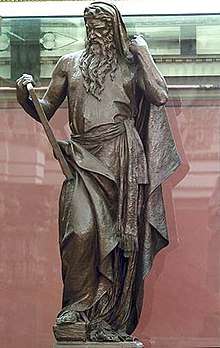
In a metaphorical sense in the Christian tradition, a "Moses" has been referred to as the leader who delivers the people from a terrible situation. Among the Presidents of the United States known to have used the symbolism of Moses were Harry S. Truman, Jimmy Carter, Ronald Reagan, Bill Clinton, George W. Bush and Barack Obama, who referred to his supporters as "the Moses generation."[125]
In subsequent years, theologians linked the Ten Commandments with the formation of early democracy. Scottish theologian William Barclay described them as "the universal foundation of all things… the law without which nationhood is impossible. …Our society is founded upon it.[126] Pope Francis addressed the United States Congress in 2015 stating that all people need to "keep alive their sense of unity by means of just legislation... [and] the figure of Moses leads us directly to God and thus to the transcendent dignity of the human being.[127]
US history
Pilgrims
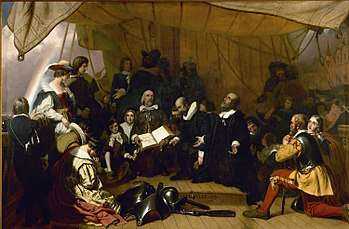
References to Moses were used by the Puritans, who relied on the story of Moses to give meaning and hope to the lives of Pilgrims seeking religious and personal freedom in North America. John Carver was the first governor of Plymouth colony and first signer of the Mayflower Compact, which he wrote in 1620 during the ship Mayflower's three-month voyage. He inspired the Pilgrims with a "sense of earthly grandeur and divine purpose," notes historian Jon Meacham,[128] and was called the "Moses of the Pilgrims."[129] Early American writer James Russell Lowell noted the similarity of the founding of America by the Pilgrims to that of ancient Israel by Moses:
Next to the fugitives whom Moses led out of Egypt, the little shipload of outcasts who landed at Plymouth are destined to influence the future of the world.[130]
Following Carver's death the following year, William Bradford was made governor. He feared that the remaining Pilgrims would not survive the hardships of the new land, with half their people having already died within months of arriving. Bradford evoked the symbol of Moses to the weakened and desperate Pilgrims to help calm them and give them hope: "Violence will break all. Where is the meek and humble spirit of Moses?"[131] William G. Dever explains the attitude of the Pilgrims: "We considered ourselves the 'New Israel,' particularly we in America. And for that reason we knew who we were, what we believed in and valued, and what our 'manifest destiny' was."[132][133]
Founding Fathers of the United States
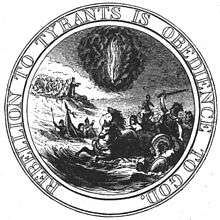
On July 4, 1776, immediately after the Declaration of Independence was officially passed, the Continental Congress asked John Adams, Thomas Jefferson, and Benjamin Franklin to design a seal that would clearly represent a symbol for the new United States. They chose the symbol of Moses leading the Israelites to freedom.[134] The Founding Fathers of the United States inscribed the words of Moses on the Liberty Bell: "Proclaim Liberty thro' all the Land to all the Inhabitants thereof." (Leviticus 25)
After the death of George Washington in 1799, two thirds of his eulogies referred to him as "America's Moses," with one orator saying that "Washington has been the same to us as Moses was to the Children of Israel."[135]
Benjamin Franklin, in 1788, saw the difficulties that some of the newly independent American states were having in forming a government, and proposed that until a new code of laws could be agreed to, they should be governed by "the laws of Moses," as contained in the Old Testament.[136] He justified his proposal by explaining that the laws had worked in biblical times: "The Supreme Being… having rescued them from bondage by many miracles, performed by his servant Moses, he personally delivered to that chosen servant, in the presence of the whole nation, a constitution and code of laws for their observance.[137]
John Adams, 2nd President of the United States, stated why he relied on the laws of Moses over Greek philosophy for establishing the United States Constitution: "As much as I love, esteem, and admire the Greeks, I believe the Hebrews have done more to enlighten and civilize the world. Moses did more than all their legislators and philosophers.[128] Swedish historian Hugo Valentin credited Moses as the "first to proclaim the rights of man."[138]
Slavery and civil rights
Historian Gladys L. Knight describes how leaders who emerged during and after the period in which slavery in the United States was legal often personified the Moses symbol. "The symbol of Moses was empowering in that it served to amplify a need for freedom."[139] Therefore, when Abraham Lincoln was assassinated in 1865 after the passage of the amendment to the Constitution outlawing slavery, Black Americans said they had lost "their Moses".[140] Lincoln biographer Charles Carleton Coffin writes, "The millions whom Abraham Lincoln delivered from slavery will ever liken him to Moses, the deliverer of Israel."[141] Similarly, Harriet Tubman, who rescued approximately seventy enslaved family and friends, was also described as the "Moses" of her people.[142]
In the 1960s, a leading figure in the civil rights movement was Martin Luther King Jr., who was called "a modern Moses," and often referred to Moses in his speeches: "The struggle of Moses, the struggle of his devoted followers as they sought to get out of Egypt. This is something of the story of every people struggling for freedom."[143]
Cultural portrayals and references
Literature
- Sigmund Freud, in his last book, Moses and Monotheism in 1939, postulated that Moses was an Egyptian nobleman who adhered to the monotheism of Akhenaten. Following a theory proposed by a contemporary biblical critic, Freud believed that Moses was murdered in the wilderness, producing a collective sense of patricidal guilt that has been at the heart of Judaism ever since. "Judaism had been a religion of the father, Christianity became a religion of the son", he wrote. The possible Egyptian origin of Moses and of his message has received significant scholarly attention.[144][145] Opponents of this view observe that the religion of the Torah seems different from Atenism in everything except the central feature of devotion to a single god,[146] although this has been countered by a variety of arguments, e.g. pointing out the similarities between the Hymn to Aten and Psalm 104.[144][147] Freud's interpretation of the historical Moses is not well accepted among historians, and is considered pseudohistory by many.[148]
- Thomas Mann's novella The Tables of the Law (1944) is a retelling of the story of the Exodus from Egypt, with Moses as its main character.[149]
- W. G. Hardy's novel All the Trumpets Sounded (1942), told a fictionalized life of Moses.[150]
Art
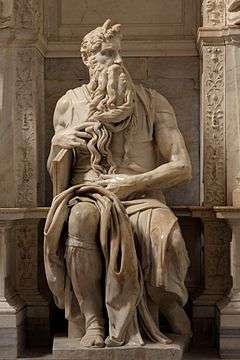
- Michelangelo's statue
Michelangelo's statue of Moses (1513-1515), in the Church of San Pietro in Vincoli, Rome, is one of the most familiar statues in the world. The horns the sculptor included on Moses' head are the result of a mistranslation of the Hebrew Bible into the Latin Vulgate Bible with which Michelangelo was familiar. The Hebrew word taken from Exodus means either a "horn" or an "irradiation." Experts at the Archaeological Institute of America show that the term was used when Moses "returned to his people after seeing as much of the Glory of the Lord as human eye could stand," and his face "reflected radiance."[151] In early Jewish art, moreover, Moses is often "shown with rays coming out of his head."[152]
Another author explains, "When Saint Jerome translated the Old Testament into Latin, he thought no one but Christ should glow with rays of light – so he advanced the secondary translation.[153][154] However, writer J. Stephen Lang points out that Jerome's version actually described Moses as "giving off hornlike rays," and he "rather clumsily translated it to mean 'having horns.'"[155] It has also been noted that he had Moses seated on a throne, yet Moses was never given the title of a King nor ever sat on such thrones.[156]
- Depiction on U.S. government buildings
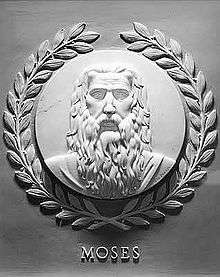
Moses is depicted in several U.S. government buildings because of his legacy as a lawgiver. In the Library of Congress stands a large statue of Moses alongside a statue of the Paul the Apostle. Moses is one of the 23 lawgivers depicted in marble bas-reliefs in the chamber of the U.S. House of Representatives in the United States Capitol. The plaque's overview states: "Moses (c. 1350–1250 B.C.) Hebrew prophet and lawgiver; transformed a wandering people into a nation; received the Ten Commandments."[157]
The other twenty-two figures have their profiles turned to Moses, which is the only forward-facing bas-relief.[158][159]
Moses appears eight times in carvings that ring the Supreme Court Great Hall ceiling. His face is presented along with other ancient figures such as Solomon, the Greek god Zeus and the Roman goddess of wisdom, Minerva. The Supreme Court Building's east pediment depicts Moses holding two tablets. Tablets representing the Ten Commandments can be found carved in the oak courtroom doors, on the support frame of the courtroom's bronze gates and in the library woodwork. A controversial image is one that sits directly above the Chief Justice of the United States' head. In the center of the 40-foot-long Spanish marble carving is a tablet displaying Roman numerals I through X, with some numbers partially hidden.[160]
Film and television
- Moses was portrayed by Theodore Roberts in Cecil B. DeMille's 1923 silent film The Ten Commandments. Moses appeared as the central character in the 1956 DeMille movie, also called The Ten Commandments, in which he was portrayed by Charlton Heston. A television remake was produced in 2006.
- Burt Lancaster played Moses in the 1975 television miniseries Moses the Lawgiver.[161]
- In the 1981 comedy film History of the World, Part I, Moses was portrayed by Mel Brooks.[162]
- Sir Ben Kingsley was the narrator of the 2007 animated film, The Ten Commandments.[163]
- Moses appeared as the central character in the 1998 DreamWorks Pictures' animated movie, The Prince of Egypt. He was voiced by Val Kilmer.[164]
- In the 2009 miniseries Battles BC, Moses was portrayed by Cazzey Louis Cereghino.[165]
- In the 2013 television miniseries The Bible, Moses was portrayed by actor William Houston.[166]
- Christian Bale portrayed Moses in Ridley Scott's 2014 film Exodus: Gods and Kings[167] which portrayed Moses and Rameses II as being raised by Seti I as cousins.[168]
- Guilherme Winter portrayed Moses in Alexandre Avancini and Vivian De Oliveira 2015–2016 Brazilian miniseries Os Dez Mandamentos and its film version The Ten Commandments: The Movie.
Criticism of Moses
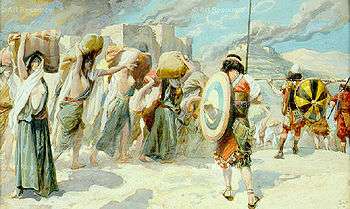
In the late eighteenth century, the deist Thomas Paine commented at length on Moses' Laws in The Age of Reason (1794, 1795, and 1807). Paine considered Moses to be a "detestable villain", and cited Numbers 31 as an example of his "unexampled atrocities".[169] In the passage, the Jewish army had returned from conquering the Midianites, and Moses went to meet it, saying angrily:
Have ye saved all the women alive? behold, these caused the children of Israel, through the counsel of Balaam, to commit trespass against the Lord in the matter of Peor, and there was a plague among the congregation of the Lord. Now, therefore, kill every male among the little ones, and kill every woman that hath known a man by lying with him; but all the women-children, that have not known a man by lying with him, keep alive for yourselves.
The prominent atheist Richard Dawkins also made reference to these verses in his 2006 book, The God Delusion, concluding that Moses was "not a great role model for modern moralists".[170]
Rabbi Joel Grossman argued that the story is a "powerful fable of lust and betrayal", and that Moses' execution of the women was a symbolic condemnation of those who seek to turn sex and desire to evil purposes.[171] Alan Levin, an educational specialist with the Reform movement, has similarly suggested that the story should be taken as a cautionary tale, to "warn successive generations of Jews to watch their own idolatrous behavior".[172]
However, some Jewish sources defend Moses' role. The Chasam Sofer emphasizes that this war was not fought at Moses' behest, but was commanded by God as an act of revenge against the Midianite women,[173] who, according to the Biblical account, had seduced the Israelites and led them to sin. In Legend of the Jews, Phinehas son of Eleazar defend their innocent action in leaving the women remain alive because Moses instructed them to take revenge "only to the Midianites," without mentioning "Midianite women."[174]
See also
- Table of prophets of Abrahamic religions
- Tharbis, according to Josephus a wife of Moses
References

Informational notes
- Hebrew: מֹשֶׁה, romanized: Mōsh´e, ISO 259-3: Moše; Syriac: ܡܘܫܐ, Mūše; Arabic: موسى M´ūsā; Greek: Mωϋσῆς, Mōÿsēs.
- Saint Augustine records the names of the kings when Moses was born in the City of God:
- According to Manetho the place of his birth was at the ancient city of Heliopolis.[29]
- According to the Orthodox Menaion, September 4 was the day that Moses saw the Land of Promise.[100]
Citations
- Filler, Elad. "Moses and the Kushite Woman: Classic Interpretations and Philo's Allegory". TheTorah.com. Retrieved 11 May 2019.
- "Moses." Random House Webster's Unabridged Dictionary.
- Deuteronomy 34:10
- Maimonides, 13 principles of faith, 7th principle.
- Seder Olam Rabbah
- Jerome's Chronicon (4th century) gives 1592 for the birth of Moses
- The 17th-century Ussher chronology calculates 1571 BC (Annals of the World, 1658 paragraph 164)
- St Augustine. The City of God. Book XVIII. Chapter 8 - Who Were Kings When Moses Was Born, And What Gods Began To Be Worshipped Then.
- Hoeh, Herman L (1967), Compendium of World History (dissertation), 1, The Faculty of the Ambassador College, Graduate School of Theology, 1962.
- Dever, William G. (1993). "What Remains of the House That Albright Built?". The Biblical Archaeologist. University of Chicago Press. 56 (1): 25–35. doi:10.2307/3210358. ISSN 0006-0895. JSTOR 3210358.
the overwhelming scholarly consensus today is that Moses is a mythical figure
- Miller II, Robert D. (25 November 2013). Illuminating Moses: A History of Reception from Exodus to the Renaissance. BRILL. p. 21. ISBN 978-90-04-25854-9.
Van Seters concluded, 'The quest for the historical Moses is a futile exercise. He now belongs only to legend.'
- William G. Dever (2001). What Did the Biblical Writers Know and When Did They Know It?: What Archeology Can Tell Us About the Reality of Ancient Israel. Wm. B. Eerdmans Publishing. p. 99. ISBN 978-0-8028-2126-3.
- Avraham Faust (2015). Israel's Exodus in Transdisciplinary Perspective: Text, Archaeology, Culture, and Geoscience. Springer. p. 476. ISBN 978-3-319-04768-3.
- Exodus 1:10
- Douglas K. Stuart (2006). Exodus: An Exegetical and Theological Exposition of Holy Scripture. B&H Publishing Group. pp. 110–13.
- Exodus 4:10
- Exodus 7:7
- Hays, Christopher B. 2014. Hidden Riches: A Sourcebook for the Comparative Study of the Hebrew Bible and Ancient Near East. Presbyterian Publishing Corp. p. 116.
- Ulmer, Rivka. 2009. Egyptian Cultural Icons in Midrash. de Gruyter. p. 269.
- Naomi E. Pasachoff, Robert J. Littman, A Concise History of the Jewish People, Rowman & Littlefield, (1995) 2005 p. 5.
- Exodus 2:10
- Maciá, Lorena Miralles. 2014. "Judaizing a Gentile Biblical Character through Fictive Biographical Reports: The Case of Bityah, Pharaoh's Daughter, Moses' Mother, according to Rabbinic Interpretations." Pp. 145–75 in Narratology, Hermeneutics, and Midrash: Jewish, Christian, and Muslim Narratives from Late Antiquity through to Modern Times, edited by C. Cordoni and G. Langer. Vandenhoeck & Ruprecht.
- Dozeman 2009, pp. 81–82.
- Greifenhagen, Franz V. 2003. Egypt on the Pentateuch's Ideological Map: Constructing Biblical Israel's Identity. Bloomsbury Publishing. pp. 60ff [62] n.65. [63].
-
εἶτα δίδωσιν ὄνομα θεμένη Μωυσῆν ἐτύμως διὰ τὸ ἐκ τοῦ ὕδατος αὐτὸν ἀνελέσθαι· τὸ γὰρ ὕδωρ μῶυ ὀνομάζουσιν Αἰγύπτιοι
"Since he had been taken up from the water, the princess gave him a name derived from this, and called him Moses, for Möu is the Egyptian word for water."
—Philo of Alexandria, De Vita Mosis, I:4:17. —Colson, F. H., trans. 1935. On Abraham. On Joseph. On Moses, (Loeb Classical Library 289). Cambridge, MA: Harvard University Press. pp. 284–85. - Scolnic, Benjamin Edidin. 2005. If the Egyptians Drowned in the Red Sea where are Pharaoh's Chariots?: Exploring the Historical Dimension of the Bible. University Press of America. p. 82.
- Salkin, Jeffrey K. 2008. Righteous Gentiles in the Hebrew Bible: Ancient Role Models for Sacred Relationships. Jewish Lights Publishing. pp. 47ff [54].
- Harris, Maurice D. 2012. Moses: A Stranger Among Us. Wipf and Stock Publishers. pp. 22–24.
- McClintock, John; James, Strong (1882), "Mo'ses", Cyclopaedia of Biblical, Theological and Ecclesiastical Literature, VI. ME-NEV, New York: Harper & Brothers, pp. 677–87.
- Exodus 2:21
- "I AM WHO I AM"; and He said, "Thus you shall say to the sons of Israel, 'I AM has sent me to you.'Exodus 3:14
- "Thus says the LORD, "Let My people go, that they may serve Me."Exodus 8:1Schmidt, Nathaniel (Feb 1896), "Moses: His Age and His Work. II", The Biblical World, 7 (2): 105–19 [108], doi:10.1086/471808,
It was the prophet's call. It was a real ecstatic experience, like that of David under the baka-tree, Elijah on the mountain, Isaiah in the temple, Ezekiel on the Khebar, Jesus in the Jordan, Paul on the Damascus road. It was the perpetual mystery of the divine touching the human.
. - Ginzberg, Louis (1909). The Legends of the Jews Vol III : Chapter I (Translated by Henrietta Szold) Philadelphia: Jewish Publication Society.
- Rad, Gerhard von; Hanson, K. C; Neill, Stephen (2012). Moses. Cambridge: James Clarke. ISBN 978-0-227-17379-4. Retrieved 2017-06-09.
- Ginzberg, Louis (1909). The Legends of the Jews Vol III : The Symbolical Significance of the Tabernacle (Translated by Henrietta Szold) Philadelphia: Jewish Publication Society.
- Ginzberg, Louis (1909). The Legends of the Jews Vol III : Ingratitude Punished (Translated by Henrietta Szold) Philadelphia: Jewish Publication Society.
- Hamilton 2011, p. xxv.
- Robinson, George (2008). Essential Torah: A Complete Guide to the Five Books of Moses. Knopf Doubleday Publishing Group. p. 97. ISBN 9780307484376.
- Meyers 2005, pp. 5–6.
- Finlay, Timothy D. (2005). The Birth Report Genre in the Hebrew Bible. Forschungen zum Alten Testament. 12. Mohr Siebeck. p. 236.
- Coats, George W. (1988). Moses: Heroic Man, Man of God. A&C Black. pp. 10ff (p. 11 Albright, pp. 29–30, Noth).
- Judges 1:16-3:11; Numbers 10:29; Exodus 6:2-3
- Smith, Mark S. (2002). The Early History of God: Yahweh and the Other Deities in Ancient Israel. Wm. B. Eerdmans. p. 34.
- van der Toorn, Karel; Becking, Bob; van der Horst, Pieter Willem, eds. (1999). Dictionary of Deities and Demons in the Bible (2nd ed.). Wm. B. Eerdmans. p. 912.
- Otto, Eckart (2006). Mose: Geschichte und Legende (in German). C. H. Beck. pp. 25–27.
- Görg, Manfred (2000). "Mose – Name und Namensträger. Versuch einer historischen Annäherung". In Otto, E. (ed.). Mose. Ägypten und das Alte Testament (in German). Stuttgart: Verlag Katholisches Bibelwerk.
- Krauss, Rolf (2001). Das Moses-Rätsel. Auf den Spuren einer biblischen Erfindung (in German). München: Ullstein Verlag.
- Assmann, Jan (2 February 2002). "Tagsüber parliert er als Ägyptologe, nachts reißt er die Bibel auf". Frankfurter Allgemeine Zeitung (in German).
- Dodson, Aidan (2010). Poisoned Legacy: The Fall of the 19th Egyptian Dynasty. American University in Cairo Press. p. 72.
- Smend, Rudolf (1995). "Mose als geschichtliche Gestalt". Historische Zeitschrift. 260: 1–19. doi:10.1524/hzhz.1995.260.jg.1.
- Leithart, Peter J. (2006). 1 & 2 Kings. Brazos Press. pp. 178ff [181–82].
- Assmann, Jan (2009). Moses the Egyptian: The Memory of Egypt in Western Monotheism. Harvard University Press. pp. 31–34.
- Samaan, Marla (2002). "'House of Bondage': Can We Reconcile the Biblical Account of Hebrew Slavery with Egyptian Historical Records?". Senior Research Projects. 59.
- Billauer, Barbara (2014). "Moses, the Tutmoses and the Exodus". SSRN. doi:10.2139/ssrn.2429297.
- Shmuel 1976, p. 1102.
- Shmuel 1976, p. 1103.
- Hammer, Reuven (1995), The Classic Midrash: Tannaitic Commentaries on the Bible, Paulist Press, p. 15.
- Droge 1989, p. 18.
- Barclay, John M. G. (1996). Jews in the Mediterranean Diaspora: From Alexander to Trajan (323 BCE – 117 CE). University of California Press. p. 130. ISBN 0-520-21843-4.
- "Moses". Jewish Encyclopedia. Retrieved 2010-03-02.
- Feldman 1998, p. 40.
- Feldman 1998, p. 133.
- Shmuel 1976, p. 1132.
- Strabo. The Geography, 16.2.35–36, Translated by H.C. Hamilton and W. Falconer in 1854, pp. 177–78,
- Shmuel 1976, p. 1133.
- Assmann 1997, p. 38.
- Tacitus, Cornelius. The works of Cornelius Tacitus: With an essay on his life and genius by Arthur Murphy, Thomas Wardle Publ. (1842) p. 499
- Tacitus, Cornelius. Tacitus, The Histories, Volume 2, Book V. Chapters 5, 6 p. 208.
- Henry J. M. Day, Lucan and the Sublime: Power, Representation and Aesthetic Experience, Cambridge University Press, 2013 p. 12.
- Louis H. Felkdman, Jew and Gentile in the Ancient World: Attitudes and Interactions from Alexander to Justinian, Princeton University Press 1996 p. 239.
- Feldman, Louis H (1998), Josephus's Interpretation of the Bible, University of California Press, p. 133.
- Shmuel 1976, p. 1140.
- Josephus, Flavius (1854), "IV", The works: Comprising the Antiquities of the Jews, VIII, trans. by William Whiston, pp. 254–55.
- Feldman 1998, p. 130.
- Guthrie 1917, p. 194.
- Guthrie 1917, p. 101.
- Blackham 2005, p. 39.
- Van Seters 2004, p. 194.
- Finkelstein, I., Silberman, NA., The Bible Unearthed: Archaeology's New Vision of Ancient Israel and the Origin of Its Sacred Texts, p. 68
- Jean-Louis Ska, The Exegesis of the Pentateuch: Exegetical Studies and Basic Questions, Forschungen zum Alten Testament, Vol 66, Mohr Siebeck, 2009 p. 260.
- Midrash Rabbah, Ki Thissa, XL. 3-3, Lehrman, p. 463
- Yalkut Shimoni, Shemot 166 to Chronicles I 4:18, 24:6; also see Vayikra Rabbah 1:3; Chasidah p. 345
- Rashi to Bava Batra 15s, Chasidah p. 345
- Bava Batra 15a on Deuteronomy 33:21, Chasidah p. 345
- Rashi to Berachot 54a, Chasidah p. 345
- Ginzberg, Louis (1909). The Legends of the Jews Vol. II : The Ascension of Moses; Moses Visits Paradise and Hell (Translated by Henrietta Szold) Philadelphia: Jewish Publication Society.
- Eusebius, Praeparatio evangelica ix. 26
- Eusebius, l.c. ix. 27
- Ginzberg, Louis (1909). The Legends of the Jews Vol. III : Moses excels all pious men (Translated by Henrietta Szold) Philadelphia: Jewish Publication Society.
- "Judaism 101: Moses, Aaron and Miriam". Jew FAQ. Retrieved 2010-03-02.
- Wolpe, David. "Ki Teitzei – A Jewish Approach to the Church Abuse Scandal." Sinai Temple Los Angeles. 25 August 2018. Sermon.
- Honorifics for the dead in Judaism.
- Larkin, William J. (1995). Acts (IVP New Testament Commentary Series). Intervarsity Press Academic. ISBN 978-0-8308-1805-1.
- "Bible Gateway passage: Acts 7 – New International Version". Bible Gateway. Retrieved 2017-01-08.
- "John 6:35 (KJV)". www.biblegateway.com. Retrieved 4 January 2020.
And Jesus said unto them, I am the bread of life: he that cometh to me shall never hunger; and he that believeth on me shall never thirst.
- Matthew 23:2
- Tomson, Peter J. (11 February 2019). Studies on Jews and Christians in the First and Second Centuries. Mohr Siebeck. p. 517. ISBN 978-3-16-154619-8.
- Great Synaxaristes: (in Greek) Ὁ Προφήτης Μωϋσῆς. 4 Σεπτεμβρίου. ΜΕΓΑΣ ΣΥΝΑΞΑΡΙΣΤΗΣ.
- Holy Prophet and God-seer Moses. OCA – Lives of the Saints.
- "September 4: The Holy God-seer Moses the Prophet and Aaron His Brother". In: The Menaion: Volume 1, The Month of September. Transl. from the Greek by the Holy Transfiguration Monastery. Boston, Massachusetts, 2005. p. 67.
- THE SUNDAY OF THE HOLY FOREFATHERS. St John's Orthodox Church, Colchester, Essex, England.
- Տոնական օրեր. Armenian Church (in Armenian). Retrieved 31 August 2017.
- Skinner, Andrew C. (1992), "Moses", in Ludlow, Daniel H (ed.), Encyclopedia of Mormonism, New York: Macmillan Publishing, pp. 958–59, ISBN 978-0-02-879602-4, OCLC 24502140
- Taylor, Bruce T. (1992), "Book of Moses", in Ludlow, Daniel H (ed.), Encyclopedia of Mormonism, New York: Macmillan Publishing, pp. 216–17, ISBN 978-0-02-879602-4, OCLC 24502140
- The Doctrine and Covenants 110:11
- Keeler 2005, pp. 55–66.
- Keeler 2005, pp. 55–56, describes Moses from the Muslim perspective: :"Among prophets, Moses has been described as the one 'whose career as a messenger of God, lawgiver and leader of his community most closely parallels and foreshadows that of Muhammad', and as 'the figure that in the Koran was presented to Muhammad above all others as the supreme model of saviour and ruler of a community, the man chosen to present both knowledge of the one God, and a divinely revealed system of law'. We find him clearly in this role of Muhammad's forebear in a well-known tradition of the miraculous ascension of the Prophet, where Moses advises Muhammad from his own experience as messenger and lawgiver."
- Azadpur, M., 2009. Charity and the Good Life: On Islamic Prophetic Ethics. In Crisis, Call, and Leadership in the Abrahamic Traditions (pp. 153-167). Palgrave Macmillan, New York.
- Keeler 2005, p. 55.
- "Sahih al-Bukhari, Book 97, Hadith 142". Sunnah.com. Retrieved 13 February 2020.
- Smith, Huston (1991), The World's Religions, Harper Collins, p. 245, ISBN 978-0-06-250811-9.
- Quran 28:7
- Quran 28:9
- Wheeler, Brannon M. (2002). Prophets in the Quran: an introduction to the Quran and Muslim exegesis. Continuum International Publishing Group. ISBN 0-8264-4957-3.CS1 maint: ref=harv (link)
- Shahada Sharelle Abdul Haqq (2012). Noble Women of Faith: Asiya, Mary, Khadija, Fatima (illustrated ed.). Tughra Books. ISBN 978-1597842686.CS1 maint: ref=harv (link)
- Quran 79:17–19
- Quran 20:47–48
- Quran 5:20
- Samuel Curtiss (2005). Primitive Semitic Religion Today. Kessinger Publishing. pp. 163–4. ISBN 1-4179-7346-3.
- Historical Context of the Bábi and Bahá'í Faiths, Bahá'i.
- Effendi, Shoghi (1988). Epistle to the Son of the Wolf. Wilmette, IL: Baháí Publishing Trust. p. 104. ISBN 978-0-87743-048-3.
- UHJ: Department of the Secretariat (15 October 1992). "Issues raised within letter". Letter to [An Individual]. Retrieved 10 June 2019.CS1 maint: ref=harv (link)
- Clifford, Laura (1937). Some Answered Questions. New York: Baha'i Publishing Trust. pp. 14–15.
- McMullen, Michael (2000), The Bahá'í: The Religious Construction of a Global Identity, p. 246.
- Ifil, Gwen (2009), The Breakthrough: Politics and Race in the Age of Obama, Random House, p. 58.
- Barclay, William (1998) [1973], The Ten Commandments, Westminster John Knox Press, p. 4.
- "Pope Francis addresses Congress", Vox, September 24, 2015
- Meacham 2006, p. 40.
- Talbot, Archie Lee (1930), A New Plymouth Colony at Kennebeck, Brunswick: Library of Congress.
- Lowell, James Russell (1913), The Round Table, Boston: Gorham Press, pp. 217–18,
Next to the fugitives whom Moses led out of Egypt, the little shipload of outcasts who landed at Plymouth are destined to influence the future of the world. The spiritual thirst of mankind has for ages been quenched at Hebrew fountains; but the embodiment in human institutions of truths uttered by the Son of Man eighteen centuries ago was to be mainly the work of Puritan thought and Puritan self-devotion. …If their municipal regulations smack somewhat of Judaism, yet there can be no nobler aim or more practical wisdom than theirs; for it was to make the law of man a living counterpart of the law of God, in their highest conception of it.
- Arber, Edward (1897), The Story of the Pilgrim Fathers, Houghton, Mifflin & Co., p. 345.
- Dever 2006, pp. ix, 234.
- Moses, Adolph (1903), Yahvism and Other Discourses, Louisville Council of Jewish Women, p. 93,
[The pilgrims were clearly] animated by the true spirit of the Hebrew prophets and law-givers. They walked by the light of the Scriptures, and were resolved to form a Commonwealth in accordance with the social laws and ideas of the Bible. …they were themselves the true descendants of Israel, spiritual children of the prophets.
. - Feiler 2009, p. 35.
- Feiler 2009, p. 102.
- Franklin, Benjamin (1834), Franklin, William Temple (ed.), Memoirs (ebook), 2, Philadelphia: McCarty & Davis, p. 504.
- Franklin 1834, p. 211.
- Shuldiner, David Philip (1999), Of Moses and Marx, Greenwood, p. 35.
- Knight, Gladys L. Icons of African American Protest Vol I, Greenwood (2009) p. 183
- Hodes, Martha (2015). Mourning Lincoln. Yale University Press. pp. 164, 237. ISBN 978-0-300-21356-0.
- Coffin, Charles Carleton (2012) [1893], Abraham Lincoln (reprint), Ulan Press, p. 534.
- Jones, Joyce Stokes; Galvin, Michele Jones (1999–2012), Beyond the Underground. Aunt Harriet, Moses of Her People.
- King, Martin Luther Jr (2000) [1957, 1968], The Papers, Univ. of California Press, p. 155,
I want to preach this morning from the subject, 'The Birth of a New Nation.' And I would like to use as a basis for our thinking together, a story that has long since been stenciled on the mental sheets of succeeding generations. It is the story of the Exodus, the story of the flight of the Hebrew people from the bondage of Egypt, through the wilderness and finally, to the Promised Land. …The struggle of Moses, the struggle of his devoted followers as they sought to get out of Egypt.
And I've looked over. And I've seen the promised land. I may not get there with you. But I want you to know tonight, that we, as a people, will get to the promised land.
- Assmann 1997.
- Yerushalmi, Y, Freud's Moses (monograph).
- "Order of the Aten Temple". Atenism. Archived from the original on 2006-09-01.
- Atwell, James E. (2000). "An Egyptian Source for Genesis 1". Journal of Theological Studies. 51 (2): 441–77. doi:10.1093/jts/51.2.441.
- Bernstein, Richard J. (1998). Freud and the Legacy of Moses. New York: Cambridge University Press. ISBN 978-0-521-63096-2.
- Britt, Brian (2004). Rewriting Moses: The Narrative Eclipse of the Text. Bloomsbury Publishing. p. 28. ISBN 978-0-567-38116-3 – via Google Books.
- Cournos, John (July 26, 1942). "Moses Reconstructed; All the Trumpets Sounded. By W.G. Hardy". The New York Times. Retrieved 2019-12-22.
- MacLean, Margaret. (ed) Art and Archaeology, Vol. VI, Archaeological Institute of America (1917) p. 97
- Devore, Gary M. (2008). Walking Tours of Ancient Rome: A Secular Guidebook to the Eternal City. Mercury Guides. p. 126. ISBN 978-0-615-19497-4.
- Thomason, Dustin; Caldwell, Ian (2005). The Rule of Four. New York: Random House. p. 151. ISBN 978-0-440-24135-5.
- Gross, Kenneth (2005). The Dream of the Moving Statue. Ithaca, NY: Cornell Univ. Press. p. 245. ISBN 978-0-271-02900-9.
- Lang, J. Stephen (2003). What the Good Book Didn't Say: Popular Myths and Misconceptions About the Bible. New York: Citadel Press. p. 114. ISBN 978-0-8065-2460-3.
- Boitani, Piero (1999). The Bible and its Rewritings. Oxford: Oxford Univ. Press. p. 126. ISBN 978-0-19-818487-4.
- "Moses relieve portrait", Architect of the Capitol
- "Relief Portraits of Lawgivers: Moses". Architect of the Capitol. 2009-02-13. Archived from the original on 2010-03-02. Retrieved 2010-03-02.
- Courtroom Friezes: North and South Walls: Information Sheet (PDF), Supreme Court of the United States.
- "In the Supreme Court itself, Moses and his law on display", Religion News Service, Christian index, archived from the original on 2009-12-07.
- Moses the Lawgiver, retrieved 2019-02-03
- "History of the World: Part I". IMDb.
- The Ten Commandments, retrieved 2019-02-03
- "Prince of Egypt". IMDb.
- Battles BC, Bryan McGowan, Cazzey Louis Cereghino, Brad C. Wilcox, retrieved 2017-12-09CS1 maint: others (link)
- "The Bible". IMDB.
- "Exodus: Gods and Kings". IMDB.
- Exodus: Gods and Kings, retrieved 2019-02-03
- Paine, Thomas (1796) The Age of Reason, part II.
- Dawkins, Richard (2006). The God Delusion Chapter 7. Bantam Press. ISBN 0-593-05548-9
- Grossman, Joel (2008), "Matot" Archived 2016-03-04 at the Wayback Machine. Temple Beth Am Library Minyan.
- Levin, Alan J. "Some messages are hard to deliver". My Jewish Learning.
- Aliya-by-Aliya Sedra Summary, Torah Tidbits, OU, archived from the original on 2003-08-02.
- Ginzberg, Louis (1909). The Legends of the Jews Vol. III : The Victorious Return from the War (Translated by Henrietta Szold) Philadelphia: Jewish Publication Society.
Further reading
- Asch, Sholem (1958), Moses, New York: Putnam, ISBN 978-0-7426-9137-7.
- Assmann, Jan (1997), Moses the Egyptian: The Memory of Egypt in Western Monotheism, Harvard University Press, ISBN 978-0-674-58738-0.
- Peter Barenboim, "Biblical Roots of Separation of Powers", Moscow, 2005, ISBN 5-94381-123-0,
- Barzel, Hillel (1974), "Moses: Tragedy and Sublimity", in Gros Louis, Kenneth RR; Ackerman, James S; Warshaw, Thayer S (eds.), Literary Interpretations of Biblical Narratives, Nashville: Abingdon Press, pp. 120–40, ISBN 978-0-687-22131-8.
- Blackham, Paul (2005), "The Trinity in the Hebrew Scriptures", in Metzger, Paul Louis (ed.), Trinitarian Soundings in Systematic Theology (essay), Continuum International.
- Buber, Martin (1958), Moses: The Revelation and the Covenant, New York: Harper.
- Card, Orson Scott (1998), Stone Tables, Deseret Book Co, ISBN 978-1-57345-115-4.
- Chasidah, Yishai (1994), "Moses", Encyclopedia of Biblical Personalities: Anthologized from the Talmud, Midrash and Rabbinic Writings, Brooklyn: Shaar Press, pp. 340–99.
- Cohen, Joel (2003), Moses: A Memoir, Mahwah, NJ: Paulist Press, ISBN 978-0-8091-0558-8.
- Churchill, Winston (November 8, 1931), "Moses", Sunday Chronicle, National Churchill Museum, Thoughts, 205.
- Daiches, David (1975), Moses: The Man and his Vision, New York: Praeger, ISBN 978-0-275-33740-7.
- Dever, William G (2002), What Did the Biblical Writers Know and When Did They Know It?, William B. Eerdmans, ISBN 978-0-8028-2126-3.
- ——— (2006) [2003], Who Were the Early Israelites, and Where Did They Come From?, Grand Rapids, MI: William B. Eerdmans
- Dozeman, Thomas B (2009), Commentary on Exodus, William B Eerdmans, ISBN 978-0-8028-2617-6CS1 maint: ref=harv (link)
- Droge, Arthur J (1989), Homer or Moses?: Early Christian Interpretations of the History of Culture, Mohr Siebeck.
- Fast, Howard (1958), Moses, Prince of Egypt, New York: Crown.
- Feiler, Bruce (2009), America's Prophet: Moses and the American Story, William Morrow.
- Feldman, Louis H (1998), Josephus's Interpretation of the Bible, University of California Press.
- Finkelstein, Israel; Silberman, Neil Asher (2001), The Bible Unearthed, New York: Free Press, ISBN 978-0-684-86912-4.
- ———; ——— (2001b), The Bible Unearthed, New York: Simon & Schuster.
- Franklin, Benjamin (1834), Franklin, William Temple (ed.), Memoirs (ebook), 2, Philadelphia: McCarty & Davis.
- Freud, Sigmund (1967), Moses and Monotheism, New York: Vintage, ISBN 978-0-394-70014-4.
- Gregory of Nyssa (1978), The Life of Moses, The Classics of Western Spirituality, Transl. Abraham J. Malherbe and Everett Ferguson. Preface by John Meyendorff, Paulist Press, ISBN 978-0-8091-2112-0. 208 pp.
- Guthrie, Kenneth Sylvan (1917), Numenius of Apamea: The Father of Neo-Platonism, George Bell & Sons
- Halter, Marek (2005), Zipporah, Wife of Moses, New York: Crown, ISBN 978-1-4000-5279-0.
- Hoffmeier, James K (1996), "Moses and the Exodus", Israel in Egypt: The Evidence for the Authenticity of the Exodus Tradition, New York: Oxford University Press, pp. 135–63.
- Hamilton, Victor (2011), Exodus: An Exegetical Commentary, Baker Books, ISBN 978-1-4412-4009-5.
- Ingraham, Joseph Holt (2006) [New York: A. L. Burt, 1859], The Pillar of Fire: Or Israel in Bondage (reprint), Ann Arbor, MI: Scholarly Publishing Office, University of Michigan Library, ISBN 978-1-4255-6491-9.
- Keeler, Annabel (2005), "Moses from a Muslim Perspective", in Solomon, Norman; Harries, Richard; Winter, Tim (eds.), Abraham's Children: Jews, Christians, and Muslims in Conversation, T&T Clark, pp. 55–66, ISBN 978-0-567-08171-1.
- Kirsch, Jonathan. Moses: A Life. New York: Ballantine, 1998. ISBN 0-345-41269-9.
- Kohn, Rebecca. Seven Days to the Sea: An Epic Novel of the Exodus. New York: Rugged Land, 2006. ISBN 1-59071-049-5.
- Freedman, H, ed. (1983), Midrash Rabbah (10 volumes), Lehman, S.M. (translator), London: The Soncino Press.
- Mann, Thomas (1943), "Thou Shalt Have No Other Gods Before Me", The Ten Commandments, New York: Simon & Schuster, pp. 3–70.
- Meacham, Jon (2006), American Gospel: God, the Founding Fathers, and the Making of a Nation, Random House.
- Salibi, Kamal (1985), "The Bible Came from Arabia", Jonathan Cape, London.
- Meyers, Carol (2005). Exodus. Cambridge University Press. ISBN 978-0-521-00291-2.CS1 maint: ref=harv (link)
- Sandmel, Samuel (1973), Alone Atop the Mountain, Garden City, NY: Doubleday, ISBN 978-0-385-03877-5.
- Van Seters, John (2004), "Moses", in Barton, John (ed.), The Biblical World, Taylor & Francis, ISBN 978-0-415-35091-4
- ——— (1994), The Life of Moses: The Yahwist as Historian in Exodus-Numbers, Peeters Publishers, ISBN 978-90-390-0112-7.
- Shmuel, Safrai (1976), Stern, M (ed.), The Jewish People in the First Century, Van Gorcum Fortress Press
- Ska, Jean Louis (2009), The Exegesis of the Pentateuch: Exegetical Studies and Basic Questions, Mohr Siebeck, pp. 30–31, 260, ISBN 978-3-16-149905-0
- Smith, Huston (1991), The World's Religions, Harper Collins, ISBN 978-0-06-250811-9
- Southon, Arthur Eustace (1954) [London: Cassell & Co., 1937], On Eagles' Wings (reprint), New York: McGraw-Hill.
- van der Toorn, K.; Becking, Bob; van der Horst, Pieter Willem (1999), Dictionary of deities and demons in the Bible, ISBN 978-0-8028-2491-2.
- Wiesel, Elie (1976), "Moses: Portrait of a Leader", Messengers of God: Biblical Portraits & Legends, New York: Random House, pp. 174–210, ISBN 978-0-394-49740-2.
- Wildavsky, Aaron (2005), Moses as Political Leader, Jerusalem: Shalem Press, ISBN 978-965-7052-31-0.
- Wilson, Dorothy Clarke (1949), Prince of Egypt, Philadelphia: Westminster Press.
External links
| Look up משה in Wiktionary, the free dictionary. |
| Wikimedia Commons has media related to Moses (Biblical figure). |
| Wikiquote has quotations related to: Moses |
| Wikisource has original works written by or about: Moses |
- The Geography, Book XVI, Chapter II The entire context of the cited chapter of Strabo's work
Moses | ||
| New title | Lawgiver | Succeeded by Joshua |
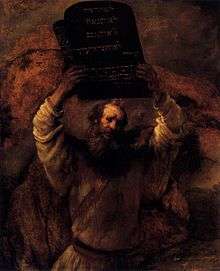
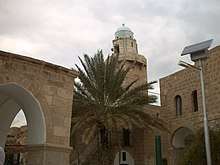
_(Mus%C3%A9e_du_Caire)_(2076972086).jpg)